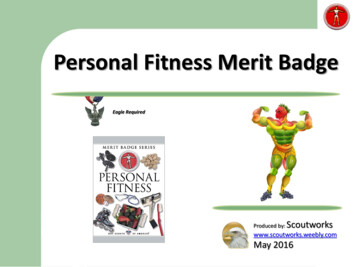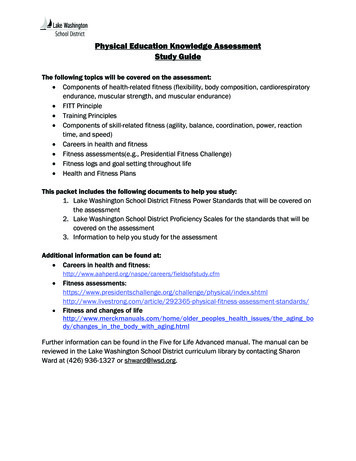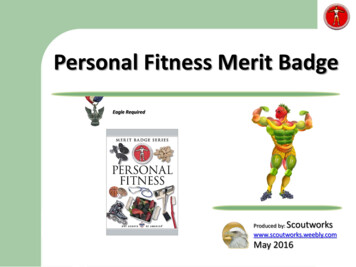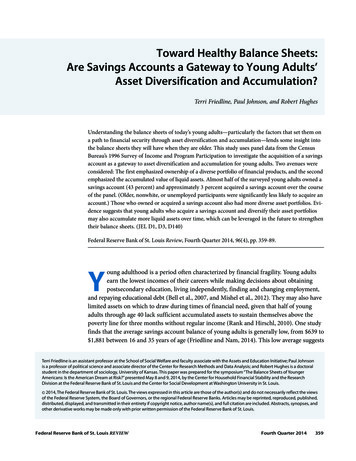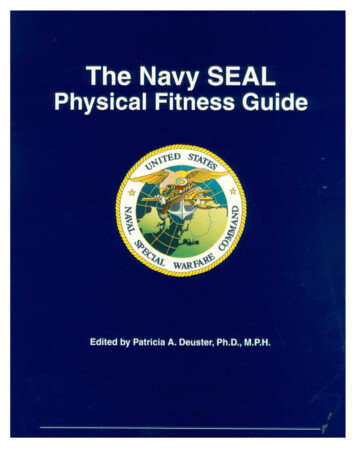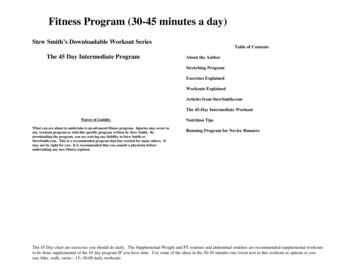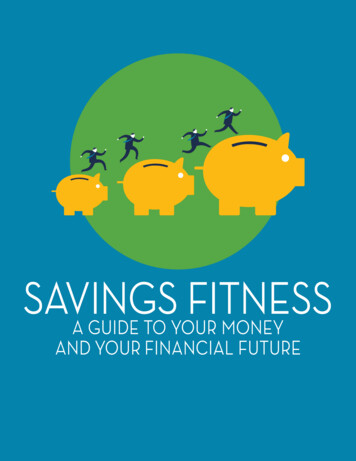
Transcription
SAVINGSFITNESSA GUIDE TO YOUR MONEYAND YOUR FINANCIAL FUTURE
This publication has been printed by the U.S. Department of Labor,Employee Benefits Security Administration (EBSA), and is available ontheir website.For a complete list of EBSA publications visit the agency’s website.To order publications or to speak with a benefits advisor, contact EBSAelectronically or call toll free 1-866-444-3272.This material will be made available in alternative format to personswith disabilities upon request:Voice phone: 202-693-8664 TTY: 202-501-3911Certified Financial Planner Board of Standards Inc. (CFP Board) is a partner in thepreparation of this publication. CFP Board owns the certification marks CFP ,andin the U.S., which it awards toCERTIFIED FINANCIAL PLANNER ,individuals who successfully complete initial and ongoing certification requirements.Visit CFP Board’s website, LetsMakeAPlan.org, for information about financialplanning and to find a financial planner who fits your needs and who is required toact in your best interest when providing financial planning advice.This booklet constitutes a small entity compliance guide for purposes of the SmallBusiness Regulatory Enforcement Fairness Act of 1996.
CONTENT HIGHLIGHTSA Financial Warmup1Your Savings Fitness Dream3How’s Your Financial Fitness?6Boost Your Financial Performance9Avoiding Financial Setbacks11Strengthening Your Fitness Plan13Personal Financial Fitness15Maximizing Your Workout Potential17Employer Fitness Program19Financial Fitness For the Self-Employed23A Lifetime of Financial Growth27Staying on Track30A Workout Worth Doing32Resources33Worksheets35SAVINGS FITNESS: A GUIDE TO YOUR MONEY AND YOUR FINANCIAL FUTURE
A FINANCIAL WARMUPMost of us know it is smart to save money for thosebig-ticket items we really want to buy – a new televisionor car or home. Yet you may not realize that probablythe most expensive thing you will ever buy in yourlifetime is your retirement.Perhaps you’ve never thought of “buying” yourretirement. Yet that is exactly what you do whenyou put money into a retirement nest egg. Youare paying today for the cost of your retirementtomorrow.its inception, Social Security has provided aminimum foundation of protection. A comfortableretirement usually requires Social Security,employer-based retirement plan benefits, personalsavings, and investments.The cost of those future years is getting moreexpensive for most Americans, for two reasons.First, we live longer after we retire – with manyof us spending 15, 25, even 30 years in retirement– and we are more active.In short, paying for the retirement you truly desireis ultimately your responsibility. You must takecharge. You are the architect of your financialfuture.Second, you may have to shoulder a greaterchunk of the cost of your retirement becausefewer companies are providing traditionalpension plans. Many retirement plans today,such as the popular 401(k), are paid for primarilyby the employee, not the employer. You maynot have a retirement plan available at workor you may be self-employed. This puts theresponsibility of choosing retirement investmentssquarely on your shoulders.That may sound like an impossible task. Manyof us live paycheck to paycheck, barely makingends meet. You may have more pressing financialneeds and goals than “buying” something so farin the future. Or perhaps you’ve waited untilclose to retirement before starting to save. Yetyou still may be able to afford to buy the kindof retirement you want. Whether you are 18 or58, you can take steps toward a better, moresecure future.Unfortunately, just about 51 percent of allprivate-sector workers are earning retirementbenefits at work, and many are not familiar withthe basics of investing. Many people mistakenlybelieve that Social Security will pay for all ormost of their retirement needs. The fact is, sinceSAVINGS FITNESS: A GUIDE TO YOUR MONEY AND YOUR FINANCIAL FUTURE1
That’s what this booklet is all about. The U.S.Department of Labor and Certified FinancialPlanner Board of Standards Inc. (CFP Board)want you to succeed in setting financial andretirement goals. Savings Fitness: A Guide toYour Money and Your Financial Future startsyou on the way to setting goals and putting yourretirement high on the list of personal priorities.The Department of Labor’s interest in retirementplanning stems from its desire to improve thesecurity of American workers in retirement. In1995, the Department launched its RetirementSavings Education Campaign. Saving is now anational priority, with the passage of the SavingsAre Vital to Everyone’s Retirement Act of 1997(SAVER). The Department continues to educateAmericans about retirement savings.CFP Board also has a keen interest in helpingAmericans meet their personal and financialgoals. A nonprofit, certifying and standardssetting organization, CFP Board’s mission is tobenefit the public by granting the CFP certification and upholding it as the recognizedstandard of excellence for competent and ethicalpersonal financial planning. To this end, CFP“A comfortableretirement usuallyrequires SocialSecurity, employerbased retirementplan benefits,personal savings,and investments.”2U.S. DEPARTMENT OF LABORBoard authorizes individuals who meet itscompetency, ethics and professional standards touse its trademarks CFP , CERTIFIED, andin theFINANCIAL PLANNER ,U.S. CFP Board currently oversees more than85,000 CFP professionals in the U.S. who adviseindividuals and families on a broad range ofpersonal finance topics, including retirement,budgeting, taxes, investments, estate planning,and insurance, among many others.This booklet shows you the key tool for making asecure retirement a reality: financial planning. Itwill help clarify your retirement goals as well asother financial goals you want to “buy” along theway. It will show you how to manage your moneyso you can afford today’s needs yet still fundtomorrow’s goals. It will help you make savingfor retirement and other goals a habit. You’ll learnthere is no such thing as starting to save too earlyor too late — only not starting at all! You’ll learnhow to save your money to make it work for you,and how to protect it so it will be there when youneed it for retirement. It explains how you cantake the best advantage of retirement plans atwork, and what to do if you’re on your own.The worksheets in the back of the bookletcan help you begin your savings fitness plan.Interactive versions of the worksheets are alsoavailable online.Yes, retirement is a big purchase. The biggestone you may ever make. Yet you can afford it —with determination, hard work, a sound savingshabit, the right knowledge, and a well-designedfinancial plan.
YOUR SAVINGSFITNESS DREAMGetting Fit Managing Your Financial LifeIt starts with a dream, the dream of a secure retirement.Yet like many people you may wonder how you canachieve that dream when so many other financial issueshave priority.Besides trying to pay for daily living expenses,you may need to buy a car, pay off debts, save foryour children’s education, take a vacation, or buya home. You may have aging parents to support.You may be going through a major event in yourlife such as starting a new job, getting married ordivorced, raising children, or coping with a deathin the family.How do you manage all these financialchallenges and at the same time try to “buy”a secure retirement? How do you turn yourdreams into reality?Start by writing down each of your goals inWorksheet 1 – Goals and Priorities in the backof this booklet. You may want to have familymembers come up with ideas. Don’t leavesomething out at this stage because you don’tthink you can afford it. This is your “wish list.”Organize them into goals you want to accomplishwithin the next 5 years or less, and goals that willtake longer than 5 years. It’s important to separatethem because, as you’ll see later, you save forshort-term and long-term goals differently.Next, organize your goals in order of priority.Make retirement a priority! This needs to beamong your goals regardless of your age. Somegoals you may be able to borrow for, such ascollege, but you can’t borrow for retirement.Write down on Worksheet 1 what you need todo to accomplish each goal: When do you wantto accomplish it, what will it cost (we’ll tell youmore about that later), what money have you setaside already, and what you are willing to do toreach the goal.Look again at the order of priority. How hardare you willing to work and save to achieve aparticular goal? Would you work extra hours, forexample? How realistic is a goal when comparedwith other goals? Reorganize their priority ifnecessary. Put those goals that are unrealistic intoyour wish list. Maybe you can turn them intoreality too.Beginning Your SavingsFitness PlanNow let’s look at your current financial resources.This is important because, as you will learn laterin this booklet, your financial resources affectnot only your ability to reach your goals, but alsoyour ability to protect those goals from potentialfinancial crises. These are also the resourcesyou will draw on to meet various life events.Worksheet 2 – Financial Documents Checklist inthe back of this booklet can help you get organized.Calculate your net worthThis isn’t as difficult as it might sound. Your networth is simply the total value of what you ownSAVINGS FITNESS: A GUIDE TO YOUR MONEY AND YOUR FINANCIAL FUTURE3
(assets) minus what you owe (liabilities). It’s asnapshot of your financial health. Use Worksheet3 – Balance Sheet to Calculate Net Worth inthe back of this booklet to write down yourinformation and do the calculation.First, add up the approximate value of all yourassets. This includes your home (if you own one)and your checking and savings accounts. Includethe current value of investments, such as stocks,real estate, certificates of deposit, retirementaccounts, IRAs, and any other retirement benefitsyou have.Now add up your liabilities: the remainingmortgage on your home, credit card debt, autoloans, student loans, income taxes due, taxes dueon the profits of your investments, if you cashedthem in, and any other outstanding bills.Subtract your liabilities from your assets. Do youhave more assets than liabilities? Or the otherway around?Your aim is to create a positive net worth,and you want it to grow each year. Your networth is part of what you will draw on to pay forfinancial goals and your retirement. A strong networth also will help you through financial crises.“You are not so muchretiring from workas you are movinginto another stageof your life.”4U.S. DEPARTMENT OF LABORReview your net worth annuallyRecalculate your net worth once a year. It’s a wayto monitor your financial health.Identify other financial resourcesYou may have other financial resources that aren’tincluded in your net worth but that can help youthrough tough times. These include the deathbenefits of your life insurance policies, SocialSecurity survivor’s benefits, health care coverage,disability insurance, liability insurance, and autoand home insurance. Although you may haveto pay for some of these resources, they offerfinancial protection in case of illness, accidents,or other catastrophes.Envision Your RetirementRetirement is a state of mind as well as a financialissue. You are not so much retiring from work asyou are moving into another stage of your life.Some people call retirement a “new career.”What do you want to do in that stage? Travel?Relax? Move to a retirement community or to benear grandchildren? Pursue a favorite hobby? Gofishing or join a country club? Work part time ordo volunteer work? Go back to school? What isthe outlook for your health? Do you expect yourfamily to take care of you if you are unable tocare for yourself? Do you want to enter this stageof your life earlier than normal retirement age orlater?The answers to these questions are crucial whendetermining how much money you will need forthe retirement you desire – and how much you’llneed to save between now and then. Let’s sayyou plan to retire early, with no plans to workeven part time. You’ll need to build a larger nestegg than if you retire later because you’ll have todepend on it far longer.
PLANNING FOR RETIREMENTWHILE YOU ARE STILLYOUNGRetirement probably seems vague andfar off at this stage of your life. Besides,you have other things to buy right now.Yet there are some crucial reasons tostart preparing now for retirement.You’ll probably have to pay for moreof your own retirement than earliergenerations. The sooner you getstarted, the better.You have one huge ally – time. Let’s saythat you put 1,000 at the beginningof each year into an IRA from age 20through age 30 (11 years) and thennever put in another dime. The accountearns 7 percent annually. When youretire at age 67 you’ll have 192,933in the account. A friend doesn’t startuntil age 30, but saves the same amountannually for 37 years straight. Despiteputting in three times as much money,your friend’s account grows to only 171,561.You can start small and grow. Evensetting aside a small portion of yourpaycheck each month will pay off in bigdollars later. Company retirement plansare the easiest way to save. If you’re notalready in your employer’s plan, sign up.You can afford to invest moreaggressively. You have years toovercome the inevitable ups and downsof the stock market.Developing the habit of saving forretirement is easier when you are young.SAVINGS FITNESS: A GUIDE TO YOUR MONEY AND YOUR FINANCIAL FUTURE5
HOW’S YOURFINANCIAL FITNESS?Estimate How Much You Need to Savefor RetirementNow that you have a clearer picture of your retirementgoal, it’s time to estimate how large your retirementnest egg will need to be and how much you need to saveeach month to buy that goal. This step is critical!The vast majority of people never take this step,yet it is very difficult to save adequately forretirement if you don’t at least have a rough ideaof how much you need to save every month.There are numerous worksheets and softwareprograms that can help you calculateapproximately how much you’ll need to save.Professional financial planners and other financialadvisors can help as well. At the end of thisbooklet, we provide Worksheet 4 – RetirementSavings to get you started.Here are some of the basic questions andassumptions to keep in mind.How much retirement incomewill I need?An easy rule of thumb is that you’ll need toreplace about 80 percent of your pre-retirementincome. If you’re making 50,000 a year (beforetaxes), you might need about 40,000 a year inretirement income to enjoy the same standard ofliving you had before retirement. Think of this asyour annual “cost” of retirement.However, no rule of thumb fits everyone.Expenses typically decline for retirees: taxes aresmaller (though not always) and work-relatedcosts usually disappear. But overall expensesmay not decline much if you still have a homeand other debts to pay off. Large medical bills6U.S. DEPARTMENT OF LABORmay keep your retirement costs high. Much willdepend on the kind of retirement you want toenjoy. Someone who plans to live a quiet, modestretirement in a low-cost part of the country willneed a lot less money than someone who plans tobe active, take expensive vacations, and live in anexpensive region.For younger people in the early stages of theirworking life, estimating income needs that maybe 30 to 40 years in the future is obviouslydifficult. Worksheet 4 can help you come upwith a rough estimate. Every year or two, reviewyour retirement plan and adjust your retirementsavings estimate as your annual earnings growand your vision of retirement begins to come intofocus.How long will I live in retirement?Based on current estimates, a male retiring atage 65 today can expect to live approximately 19years in retirement. A female retiring today at age65 can expect to live approximately 21 years.These are average figures and how long you canexpect to live will depend on factors such asyour general health and family history. But usingtoday’s average or past history may not give youa complete picture. People are living longer todaythan they did in the past, and virtually all expertopinion expects the trend toward living longer tocontinue.
What other sources of incomewill I have?You can get your Social Security statementand an estimate of your retirement benefits onthe Social Security Administration’s website.For more information, visit their website or call1-800-772-1213.Will you have other sources of income?For instance, will you receive retirement benefitsthat provide a specific amount of retirementincome each month? Is the benefit adjusted forinflation?What savings do I already havefor retirement?You’ll need to build a nest egg sufficient to makeup the gap between the total amount of incomeyou will need each year and the amount providedannually by Social Security and any retirementincome. This nest egg will come from yourretirement plan accounts at work, IRAs, annuities,and personal savings.What adjustments must be madefor inflation?The cost of retirement will likely go up everyyear due to inflation -- that is, 40,000 won’t buyas much in year 5 of your retirement as it will thefirst year because the cost of living usually rises.Although Social Security benefits are adjustedfor inflation, any other estimates of how muchincome you need each year – and how muchyou’ll need to save to provide that income – mustbe adjusted for inflation. The average annualinflation rate over the last century is about 3percent, varying over time. In 1980, for instance,the annual inflation rate was 13.5 percent; in1998, it reached a low of 1.6 percent. Whenplanning for your retirement it is always saferto assume a higher, rather than a lower, rate andhave your money buy more than you previouslythought.What will my investments return?Any calculation must take into account whatannual rate of return you expect to earn on thesavings you’ve already accumulated and on thesavings you intend to make in the future. Youalso need to determine the rate of return on yoursavings after you retire. These rates of return willdepend in part on whether the money is inside oroutside a tax-deferred account.It’s important to choose realistic annual returnswhen making your estimates. Most financialplanners recommend that you stick with thehistorical rates of return based on the types ofinvestments you choose or even slightly lower.How many years do I have left untilI retire?The more years you have, the less you’ll have tosave each month to reach your goal.How much should I save each month?Once you determine the number of years untilyou retire and the size of the nest egg you need to“buy” in order to provide the income not providedby other sources, you can estimate how much youneed to save.It’s a good idea to revisit this worksheet at leastevery year or two. Your vision of retirement, yourearnings, and your financial circumstances maychange. You’ll also want to check periodically tobe sure you are achieving your objectives alongthe way.SAVINGS FITNESS: A GUIDE TO YOUR MONEY AND YOUR FINANCIAL FUTURE7
HOW TO PREPARE FORRETIREMENT WHEN THERE’SLITTLE TIME LEFTWhat if retirement is just around thecorner and you haven’t saved enough?Here are some tips. Some are painful,but they’ll help you toward your goal.n It’s never too late to start. It’s onlytoo late if you don’t start at all.n Sock it away. Pump everything youcan into your tax-sheltered retirementplans and personal savings. Try toput away at least 20 percent of yourincome.n Reduce expenses. Funnel the savingsinto your nest egg.n Take a second job or work extrahours.n Make sure your investments arepart of the solution, not part of theproblem. To boost your returns,8U.S. DEPARTMENT OF LABORdiversify your holdings and keepan eye on fees. But don’t take risksyou can’t afford and don’t trade toomuch.n Retire later. You may not need towork full time beyond your plannedretirement age. Part time may beenough.n Refine your goal. You may haveto live a less expensive lifestyle inretirement.n Delay taking Social Security. Benefitswill be higher when you start takingthem.n Make use of your home. Rent out aroom or move to a less expensivehome and save the profits.n Sell assets that are not producingmuch income or growth, such asundeveloped land or a vacationhome, and invest in incomeproducing assets.
BOOST YOUR FINANCIALPERFORMANCE“Spend” for RetirementNow comes the tough part. You have a rough idea ofhow much you need to save each month to reach yourretirement goal. But how do you find that money?Where does it come from?There’s one simple trick for saving for any goal:spend less than you earn. That’s not easy if youhave trouble making ends meet or if you findit difficult to resist spending whatever moneyyou have in hand. Even people who make highincomes often have difficulty saving. But we’vegot some ideas that may help you.month, such as car insurance or self-employmenttaxes. Review your checkbook, credit and debitcard records, and receipts to estimate expenses.You will probably need to track how youspend cash for a month or two. Most of us aresurprised to find out where and how much cash“disappears” each month.Let’s start with a “spending plan” – a guide forhow we want to spend our money. Some peoplecall this a budget, but since we’re thinking ofretirement as something to buy, a spending planseems more appropriate.Include savings as an expenseBetter yet, put it at the top of your expense list.Here’s where you add in the total of the amountsyou need to save each month to accomplish thegoals you wrote down earlier in Worksheet 1.A spending plan is simple to set up. Considerthe following steps as a guide as you fill inthe information in Worksheet 5 – Cash FlowSpending Plan in the back of this booklet.IncomeAdd up your monthly income: wages, averagetips or bonuses, alimony payments, investmentincome, and so on. Don’t include anything youcan’t count on, such as lottery winnings or abonus that’s not definite.ExpensesAdd up monthly expenses: mortgage or rent,car payments, average food bills, medicalexpenses, entertainment, and so on. Determinean average for expenses that vary each month,such as clothing, or that don’t occur everySubtract expenses from incomeWhat if you have more expenses (includingsavings) than you have income? Not anuncommon problem. You have three choices:cut expenses, increase income, or both.Cut expensesThere are hundreds of ways to reduce expenses,from clipping grocery coupons and bargainhunting to comparison shopping for insurance“Make saving a habit.It’s not difficult onceyou start.”SAVINGS FITNESS: A GUIDE TO YOUR MONEY AND YOUR FINANCIAL FUTURE9
TIPSEven after you’ve tried to cut expensesand increase income, you may still havetrouble saving enough for retirementand your other goals. Here are sometips.n Pay yourself first. Put away firstthe money you want to set aside forgoals. Have money automaticallywithdrawn from your checkingaccount and put into savings or aninvestment. Join a retirement plan atwork that deducts money from yourand buying new cars less often. The section thatfollows on debt and credit card problems willhelp. You also can find lots of expense-cuttingideas in books, magazine articles, and financialnewsletters.10U.S. DEPARTMENT OF LABORpaycheck. Or deposit your retirementsavings yourself, the first thing. Whatyou don’t see, you don’t miss.n Put bonuses and raises towardsavings.n Make saving a habit. It’s not difficultonce you start.n Revisit your spending plan everyfew months to be sure you are ontrack. Income and expenses changeover time.Increase incomeTake a second job, improve your job skills oreducation to get a raise or a better paying job,make money from a hobby, or jointly decide thatanother family member will work.
AVOIDING FINANCIALSETBACKSAvoid Debt and Credit ProblemsHigh debt and misuse of credit cards make it tough tosave for retirement. Money that goes to pay interest, latefees, and old bills is money that could earn money forretirement and other goals.How much debt is too much debt?Debt isn’t necessarily bad, but too much debtis. Add up what you pay monthly in car loans,student loans, credit card and charge card loans,personal loans – everything but your mortgage.Divide that total by the money you bring homeeach month. The result is your “debt ratio.” Tryto keep that ratio to 10 percent or less. Totalmortgage and nonmortgage debt payments shouldbe no more than 36 percent of your take-homepay.What’s the difference between “gooddebt” and “bad debt”?Yes, there is such a thing as good debt. That’s debtthat can provide a financial pay off. Borrowingto buy or remodel a home, pay for a child’seducation, advance your own career skills, or buya car for getting to work can provide long-termfinancial benefits.Do you have debt problems?Here are some warning signs:n Borrowing to pay off other loans.n Creditors calling for payment.n Paying only the minimum on credit cards.n Maxing out credit cards.n Borrowing to pay regular bills.n Being turned down for credit.Avoid high-interest rate loansLoan solicitations that come in the mail, pawningitems for cash, or “payday” loans in which peoplewrite postdated checks to check-cashing servicesare usually extremely expensive. For example,rolling over a payday loan every 2 weeks fora year can run up interest charges of over 600percent! While the Truth-in-Lending Act requiresBad debt is when you borrow for things that don’t lenders to disclose the cost of your loan expressedprovide financial benefits or that don’t last as long as an annual percentage rate (APR), it is up toas the loan. This includes borrowing for vacations, you to read the fine print telling you exactly whatclothing, furniture, or dining out.the details of your loan and its costs are.The key to recognizing just how expensive theseloans can be is to focus on the total cost of theloan – principal and interest. Don’t just look atthe monthly payment, which may be small, butadds up over time.SAVINGS FITNESS: A GUIDE TO YOUR MONEY AND YOUR FINANCIAL FUTURE11
HERE ARE SOMEADDITIONAL TIPS FORHANDLING CREDITCARDS WISELYn Keep only one or two cards, notthe usual eight or nine.n Don’t charge big-ticket items. Findless expensive loan alternatives.n Shop around for the best interestrates, annual fees, service fees, andgrace periods.n Pay off the card each month, or atleast pay more than the minimum.Handle credit cards wiselyCredit cards can serve many useful purposes, butpeople often misuse them. Take, for example,the habit of making only the 2 percent minimumpayment each month. On a 2,000 balance with acredit card charging 18 percent interest, it wouldtake 30 years to pay off the amount owed. Thenimagine how fast you would run up your debts ifyou did this with several credit cards at the sametime. (For more information on handling creditwisely, see the “Resources” section at the end ofthis booklet.)12U.S. DEPARTMENT OF LABORn Still have problems? Leave thecards at home or cut them up.How to climb out of debtDespite your best efforts, you may find yourselfin severe debt. Worksheet 6 – Debt Reductionin the back of this booklet can help you comeup with a plan to pay down your credit cardand other bad debt. A credit counseling servicecan help you set up a plan to work with yourcreditors and reduce your debts. Or you can workwith your creditors directly to try and work outpayment arrangements.
STRENGTHENINGYOUR FITNESS PLANSaving for RetirementOnce you’ve reduced unnecessary debt and created aworkable spending plan that frees up money, you’reready to begin saving toward retirement.You may do this through a company retirementplan or on your own – options that are covered inmore detail later in this booklet. First, however,let’s look at a few of the places where you mightput your money for retirement.n Savings accounts, money market mutualfunds, certificates of deposit, and U.S.Treasury bills. These are sometimes referredto as cash or cash equivalents because you canget to them quickly and there’s little risk oflosing the money you put in.n Domestic bonds. You loan money to a U.S.company or a government body in return forits promise to pay back what you loaned, withinterest.n Domestic stocks. You own part of a U.S.company.n Mutual funds. Instead of investing directly instocks, bonds, or real estate, for example, youcan use mutual funds. These pool your moneywith money of other shareholders and investit for you. A stock mutual fund, for example,would invest in stocks on behalf of all thefund’s shareholders. This makes it easier toinvest and to diversify your money.Choosing where to putyour moneyHow do you decide where to put your money?Look back at the short-term goals you wrotedown earlier – a family vacation, perhaps, orthe down payment for a home. Remember, youshould always be saving for retirement. But, forgoals you want to happen soon – say, within ayear – it’s best to put your money into one ormore of the cash equivalents – a bank account orCD, for example. You’ll earn a little interest andthe money will be there when you need it.For goals that are at least 5 years in the future,however, such as retirement, you may want toput some of your money into stocks, bonds, realestate, foreign investments, mutual funds, orother assets. Unlike savings accounts or bankCDs, these types of investments typically are notinsured by the federal government. There is therisk that you can lose some of your money. Howmuch risk depends on the type of investment.Generally, the longer you have until retirementand the greater your other sources of income,the more risk you can afford. For those who willbe retiring soon and who will depend on theirinvestment for income during their retirementyears, a low-risk investment strategy is moreprudent. Only you can decide how much riskto take.SAVINGS FITNESS: A GUIDE TO YOUR MONEY AND YOUR FINANCIAL FUTURE13
Why take any ris
Certified Financial Planner Board of Standards Inc. (CFP Board) is a partner in the preparation of this publication. CFP Board owns the certification marks CFP , CERTIFIED FINANCIAL PLANNER , and . in the U.S., which it awards to individuals who successfully
